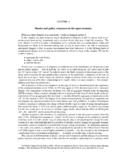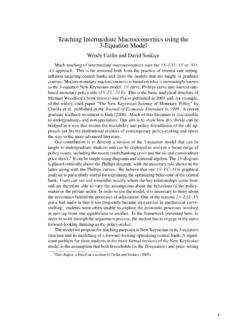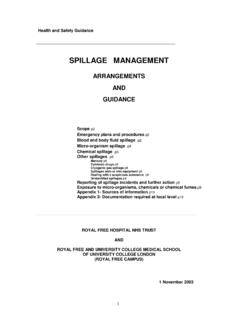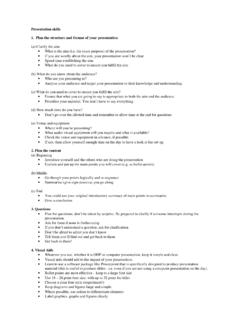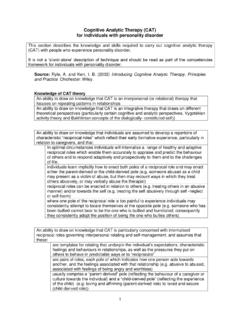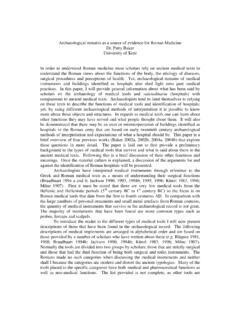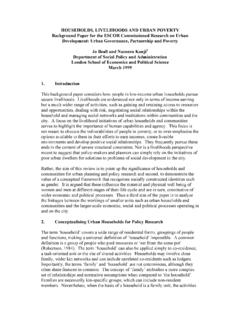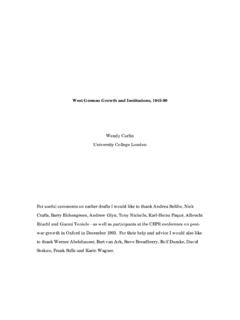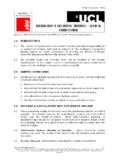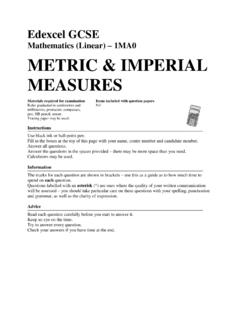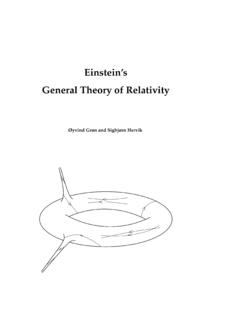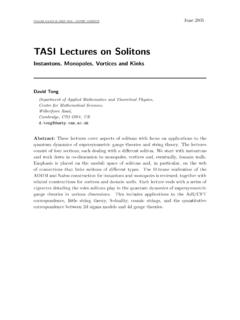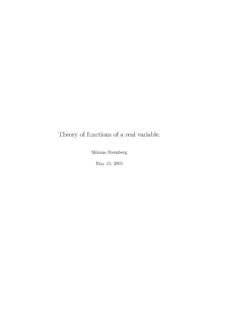Transcription of Compactness in metric spaces - UCL
1 MATHEMATICS 3103 (Functional Analysis)YEAR 2012 2013, TERM 2 HANDOUT #2: Compactness OF metric SPACESC ompactness in metric spacesThe closed intervals [a, b] of the real line, and more generally the closed bounded subsetsofRn, have some remarkable properties, which I believe you have studied in your course inreal analysis. For instance:Bolzano Weierstrass bounded sequence of real numbers hasa convergent can be rephrased as:Bolzano Weierstrass theorem (rephrased).LetXbe any closed boundedsubset of the real line. Then any sequence (xn) of points inXhas a subsequenceconverging to a point ofX.(Whyis this rephrasing valid? Note that this property doesnothold ifXfails to be closedor fails to be bounded why?) And here is another example:Heine Borel covering of a closed interval [a, b] or moregenerally of a closed bounded setX R by a collection of open sets has afinite theorems are not only interesting they are also extremely useful in applications, aswe shall see.
2 So our goal now is to investigate the generalizations of these concepts to begin with some definitions: Let (X, d) be a metric space . AcoveringofXis acollection of sets whose union isX. Anopen coveringofXis a collection ofopensetswhose union isX. The metric spaceXis said to becompactif every open covering hasa finite abstracts the Heine Borel property; indeed, the Heine Boreltheorem states that closed bounded subsets of the real line are can rephrase Compactness in terms of closed sets by makingthe following observation:IfUis an open covering ofX, then the collectionFofcomplementsof sets inUis a collectionof closed sets whose intersection is empty (why?); and conversely, ifFis a collection of closedsets whose intersection is empty, then the collectionUof complements of sets inFis an opencovering.
3 Thus, a spaceXis compact if and only if every collection of closed sets withanempty intersection has a finite subcollection whose intersection is also empty. Or, passing tothe contrapositive, we can put it another way by making the following definition: a collectionFof sets is said to have thefinite intersection propertyif every finite subcollection ofFhas a nonempty intersection. We have then shown:1Or more formally: If (U ) I(whereIis some index set) is a collection of open sets ofXsatisfying IU =X, then there exists a finite subsetJ Isuch that JU = metric spaceXis compact if and only if every collectionFof closedsets inXwith the finite intersection property has a nonempty far so good; but thus far we have merely made a trivial reformulation of the definitionof Compactness .
4 Let us go farther by making another definition:A metric spaceXis said to besequentially compactif every sequence (xn) n=1ofpoints inXhas a convergent subsequence. This abstracts the Bolzano Weierstrass property;indeed, the Bolzano Weierstrass theorem states that closed bounded subsets of the real lineare sequentially finally, let us make another definition: A metric space (X, d) is said to betotallybounded(orprecompact) if, for every >0, the spaceXcan be covered by a finite familyof open balls of radius . (You could alternatively use closed balls and get the same concept why?) Another way of saying this is: A metric space (X, d) is totally bounded if, forevery >0, there exists a finite subsetA Xsuch thatd(x, A)< for allx X. (Why isthis equivalent?) Any such finite subset is called an then have the following fundamental theorem characterizing compact metric spaces :Theorem ( Compactness of metric spaces )For a metric spaceX, the following areequivalent:(a)Xis compact, every open covering ofXhas a finite subcovering.
5 (b) Every collection of closed sets inXwith the finite intersection property has a nonemptyintersection.(c) IfF1 F2 F3 ..is a decreasing sequence of nonempty closed sets inX, then n=1 Fnis nonempty.(d)Xis sequentially compact, every sequence inXhas a convergent subsequence.(e)Xis totally bounded and have already proved the equivalence of (a) and (b). Let us now prove (b) = (c)= (d) = (e) = (a).Proof of (b)= (c).This is trivial, since adecreasingsequence ofnonemptyclosedsets obviously has the finite intersection property. (Why? Ifn1, .. , nkare given indices,what isFn1 Fn2 .. Fnk?) Proof of (c)= (d).Let (xn) be a sequence of points inX, and letFnbe the closure ofthe set{xn, xn+1, xn+2, ..}. The family of sets{Fn}is decreasing ( F2 F3 ..),and all the setsFnare nonempty and closed.
6 Therefore, by (c), the set n=1 Fncontains2 Some authors ( Kolmogorov Fomin) define an -net to be any finite subsetA Xsuch thatd(x, A) for allx X, withnon-strictinequality. This changes slightly the statements of proofsbut makes noessential difference can you see why?2at least one pointa. Then it is easy to see that (xn) contains a subsequence convergingtoa: for instance, setn1= 1 and then letnkbe the smallest integer> nk 1such thatd(xnk, a)<1/k; such an integer exists becauseabelongs to all the setsFn. (You shouldmake sure you understand this last step.) Proof of (d)= (e).To prove thatXis complete, let (xn) be any Cauchy sequenceinX. By (d), (xn) contains a subsequence converging to some pointa X. But then, byProposition (see last week s notes), the whole sequence (xn) converges toa.
7 This showsthatXis suppose thatXis not totally bounded, there exists a number >0 such thatXhas no finite covering by open balls of radius . Then we can define a sequence (xn) n=1ofpoints inXhavingd(xi, xj) for alli6=j, by the following inductive construction: Firstletx1be any point inX. Then, supposing thatx1, .. , xn 1have been chosen, we know thatthe union of the open balls of centerxi(1 i n 1) and radius is not the whole space ,hence we can choose a pointxnsatisfyingd(xi, xn) for alli < n. When we are done, wehaved(xi, xj) for alli6=j(why?). On the other hand, the sequence (xn) cannot haveany convergent subsequence; for if it had a subsequence (xnk) converging toa, then therewould exist an integerk0such thatd(xnk, a)< /2 for allk k0, and hence by the triangleinequalityd(xnk, xnk )< for allk, k k0, contrary to the definition of the sequence (xn).
8 3 Proof of (e)= (a).Suppose thatXis not compact, we have an open covering(U ) IofXsuch that no finite subfamily is a covering ofX. We will define a sequence(xn) n=1of points inX, as follows: First choose an -net with = 1/2 (this is possiblebecauseXis totally bounded), and letx1be any element of that -net with the propertythat no finite subfamily of (U ) Iis a covering ofB(x1,1/2). [Such an element has to exist,because if every ball of radius 1/2 centered at a point of the -net had a finite subcoverfrom (U ) I, then the whole spaceXwould have a finite subcover from (U ) I(why?).]Next choose an -net with = 1/4, and letx2be any element of that -net satisfyingB(x1,1/2) B(x2,1/4)6= and having the property that no finite subfamily of (U ) Iis a covering ofB(x2,1/4).
9 [Such an element has to exist, because if every ball of radius1/4 centered at a point of the -net and having nonempty intersection withB(x1,1/2) hada finite subcover from (U ) I, thenB(x1,1/2) would have a finite subcover from (U ) I(why?).] Continue analogously: at thenth stage, choose an -net with = 1/2n, and letxnbe any element of that -net satisfyingB(xn 1,1/2n 1) B(xn,1/2n)6= and having theproperty that no finite subfamily of (U ) Iis a covering ofB(xn,1/2n).It follows from this construction thatd(xn 1, xn) 12n 1+12n 12n 2( )(why?) and hence that, form < n,d(xm, xn) d(xm, xm+1) +d(xm+1, xm+2) +..+d(xn 1, xn)( )3 Another way of stating this argument is: The sequence (xn) clearly cannot have any Cauchy subsequence;therefore, it cannot have any convergent 12m 1+12m+.
10 +12n 2( ) 12m 2,( )which shows that (xn) is a Cauchy sequence inX. SinceXis complete, the sequence (xn)converges to some pointa let 0 Ibe an index such thata U 0(why must such an index exist?). Thereexists >0 such thatB(a, ) U 0. By the definition ofa, there exists an integernsuchthatd(xn, a)< /2 and also 1/2n< /2 (why?). The triangle inequality then shows thatB(xn,1/2n) B(a, ) U 0( )(why?). But this contradicts the fact that no finite subfamily of (U ) Iis a covering ofB(xn,1/2n). Whew! Warning:For general (nonmetrizable) topological spaces , Compactness isnotequivalentto sequential also have the following easy fact:Proposition totally bounded metric space (and in particular everycompact met-ric space ) is totally bounded, then there exists for eachna finite subsetAn Xsuchthat, for everyx X,d(x, An)<1/n.
